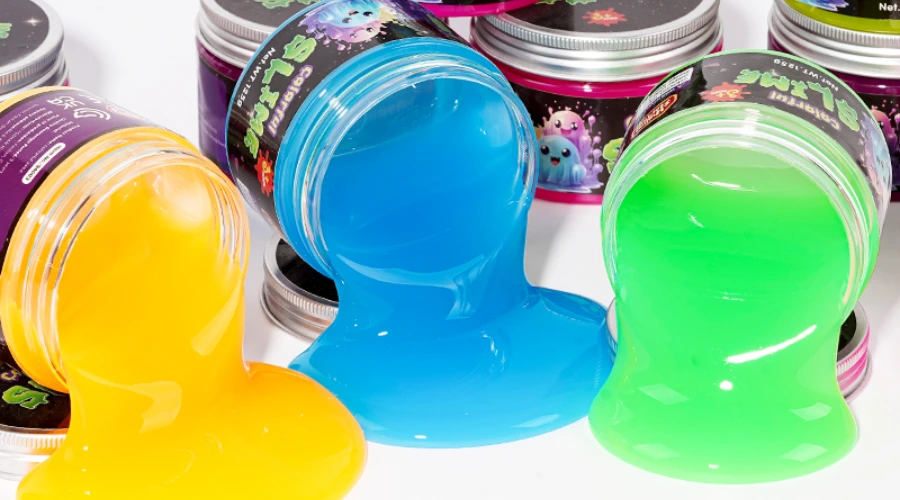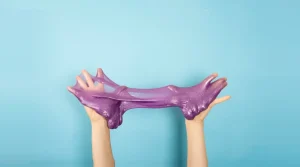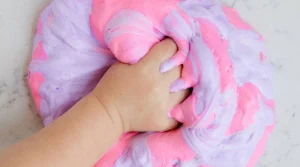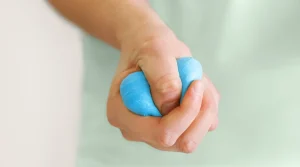
What Is Thermochromic Slime? Science of Color-Changing Play
Uncover the science of thermochromic slime — where chemistry meets creativity through playful, color-changing reactions.
#1 Toys Manufacturer in China. WhatsApp: +86 180-0088-4063. Email: [email protected]
#1 Toys Manufacturer in China. WhatsApp: +86 180-0088-4063. Email: [email protected]

Slime toys are often seen as playful goo, but they are more than that. They combine texture, motion, and response to touch, inviting children to explore in ways other toys cannot. From sensory stimulation to early experimentation, slime offers a unique medium for observation and interaction.
Slime first gained widespread attention in the 1970s with store-bought kits, but the concept of malleable, stretchy substances for play dates back further. Early versions used household polymers to create tactile fun for children in classrooms and at home.
Its popularity surged in recent years with social media, videos, and hands-on demonstrations. Children and educators alike noticed that slime toys allow repeated experimentation. Stretching, poking, and molding the material satisfies curiosity while subtly teaching about properties like elasticity, viscosity, and flow. According to Frontiers in Psychology (2021), hands-on materials like slime enhance exploratory behavior in early childhood.
Unlike blocks, dolls, or electronic gadgets, slime toys respond in ways children control entirely. Pull it, stretch it, fold it, or press it, and it reacts. This tactile feedback distinguishes slime from more static toys, allowing children to learn through direct interaction.
Slime also exists in a semi-solid state, which is scientifically intriguing. It behaves like both a liquid and a solid—a viscoelastic material. Children intuitively explore these properties, testing cause and effect, elasticity, and resistance. This real-world observation helps them understand physical properties without formal instruction.
Children approach slime toys in varied ways. Some like slow, careful stretching, observing how it bends and folds. Others enjoy quick pokes or squishes, noting its snap-back reaction. These behaviors reflect natural curiosity and experimentation.
Teachers and psychologists have observed that this interaction is often self-directed. A child may mix colors, press textures, or measure lengths with slime, learning by trial and error. This hands-on engagement resembles miniature scientific investigations, turning playtime into a lab of tactile exploration.
Slime toys provide a rich sensory experience that goes beyond sight or sound. Through touch, pressure, and movement, children explore texture, resistance, and form. The material invites repetition and curiosity, giving learners a direct way to experience physical properties in a controlled environment.
Slime engages multiple aspects of the sense of touch. Children notice differences in temperature, stickiness, and elasticity as they manipulate it. This tactile feedback helps them distinguish between soft, firm, and flowing textures.
Psychologists note that repeated tactile interaction, like squeezing slime, can refine sensory perception. According to Frontiers in Psychology (2021), tactile play promotes neural development in areas responsible for touch and fine motor control. Children naturally experiment, pressing, stretching, or rolling the slime to see how it responds.
Using slime requires precise hand movements. Stretching it slowly or rolling it into small shapes strengthens finger and hand muscles. Squeezing, folding, and poking each provide different challenges for coordination.
Studies in Early Child Development and Care (2020) suggest that repetitive hand activities with pliable materials improve dexterity, control, and timing. Children molding slime into long strands or small spheres are practicing subtle movements that later support tasks like writing or cutting with scissors.
Slime can help children integrate multiple senses simultaneously. While touching, they also see how it stretches and moves, sometimes hearing slight squishes. This multisensory feedback enhances perception and attention.
Occupational therapists often use slime to support children with sensory processing differences. American Journal of Occupational Therapy (2019) reports that controlled tactile play with viscoelastic materials can improve focus and self-regulation. Slime becomes a tool for learning how touch, motion, and sight work together in everyday tasks.
Slime toys offer more than sensory fun—they create opportunities for thinking and experimenting. As children pull, stretch, and mold the material, they naturally test ideas, solve small problems, and explore outcomes. The flexible, responsive nature of slime turns play into hands-on learning.
When children manipulate slime, they engage in trial-and-error experiments. Stretching it too far might snap it; folding it repeatedly may change its shape. Each action is a small lesson in observation and control.
Research in Early Childhood Research Quarterly (2021) notes that repeated hands-on experimentation helps develop executive function skills, such as planning, attention, and task persistence. Through simple actions like stretching and tearing slime, children learn to predict outcomes and adjust strategies.
Slime naturally demonstrates cause and effect. A quick poke creates a ripple; a slow stretch keeps it intact. These subtle reactions help children connect their actions to results, reinforcing logical thinking.
Psychologists emphasize that cause-and-effect learning is foundational for later problem-solving. Frontiers in Psychology (2020) shows that tactile materials with predictable reactions enhance early scientific reasoning, as children intuitively test forces, tension, and elasticity. Slime serves as a tangible, safe way to explore these concepts.
Slime is also an open-ended medium for imagination. Children can create abstract shapes, pretend objects, or even simulate natural phenomena like lava or rivers. This creative engagement fosters divergent thinking.
Even without instructions, slime allows children to invent, modify, and repeat scenarios, strengthening imagination and cognitive flexibility. Educational research (Journal of Early Childhood Education Research, 2019) highlights that open-ended play materials like slime encourage both problem-solving and inventive thinking, supporting holistic development in early childhood.
Slime toys are not just about hands-on experimentation—they also offer emotional support. Through tactile play, children can regulate feelings, reduce stress, and focus attention. The repetitive, malleable nature of slime provides a subtle rhythm that encourages calm and concentration.
Many children find the stretching and squishing of slime naturally soothing. The sensory feedback gives a predictable response, helping the mind settle. Occupational therapists often recommend viscoelastic materials to help maintain attention during learning activities.
A study in American Journal of Occupational Therapy (2019) showed that children using tactile toys, including slime, experienced lower stress and improved self-regulation. The repetitive motions provide a gentle, nonverbal way to center attention and reduce tension.
Slime allows children to externalize feelings safely. Pressing, pulling, or shaping it can be a quiet outlet for frustration, excitement, or curiosity. Children often narrate their play, giving voice to thoughts and emotions indirectly.
Psychologists note that tactile materials like slime offer children a controlled environment to experiment with intensity and control. They can modulate pressure and speed, effectively practicing emotional regulation without direct instruction.
Playing with slime encourages present-moment awareness. Children focus on texture, movement, and sensation, creating a mindfulness-like state. Observing how slime stretches or slowly flows helps them notice details and connect mind and body.
Research in Frontiers in Psychology (2020) suggests that hands-on, sensory play enhances attention span and awareness in young children. Slime, by engaging multiple senses simultaneously, provides an accessible and enjoyable introduction to mindful, focused activity.
Slime toys are not only individual play tools—they can also support social and cooperative learning. When children explore slime together, they learn to share space, negotiate turns, and collaborate creatively. Group slime play often becomes a rich environment for both communication and problem-solving.
When multiple children play with slime simultaneously, sharing and turn-taking become natural lessons. One child may offer a container, another might suggest mixing colors, and together they negotiate actions and outcomes.
Studies in Child Development (2018) show that cooperative play with tactile materials strengthens social reasoning and teaches conflict resolution. Children learn that collaboration can enhance creativity while also practicing patience and empathy.
Slime often inspires imaginative storytelling. A child may transform slime into “lava,” “mud,” or “alien goo,” narrating events as they play. Roleplay and narrative creation help children practice language, sequencing, and descriptive skills.
According to Early Childhood Research Quarterly (2020), storytelling during sensory play boosts vocabulary, narrative skills, and social understanding. Slime becomes more than a tactile object—it’s a prompt for verbal expression and imaginative dialogue.
Slime encourages gentle collaboration because it invites observation and imitation. Children may watch peers stretch, fold, or combine slime and experiment in response, learning by seeing others’ techniques.
Research in Frontiers in Psychology (2021) indicates that peer observation in sensory play enhances learning through social modeling. Children pick up new strategies and refine motor skills while engaging in enjoyable, cooperative activities.
Slime toys provide hands-on opportunities for children to explore scientific and creative concepts. Through tactile play, they can observe reactions, experiment with properties, and develop problem-solving skills. These open-ended experiences make abstract ideas tangible and engaging.
Slime naturally encourages experimentation. Children can stretch it, mix colors, or test how it responds to different forces. Each interaction acts as a small-scale scientific experiment, fostering curiosity and observation skills.
Research in Frontiers in Psychology (2020) highlights that young children who engage in repeated tactile experimentation improve their ability to predict outcomes and notice patterns. Slime play provides a low-stakes environment for hypothesis testing and trial-and-error learning.
Slime demonstrates basic scientific principles in an intuitive way. Children can explore viscosity, elasticity, and malleability, noticing that slime behaves like both a liquid and a solid. They learn about texture, cohesion, and transformation simply through touch and manipulation.
Educational studies (Journal of Chemical Education, 2019) suggest that hands-on materials help children understand states of matter more effectively than abstract explanations alone. Slime offers a tangible experience that links physical properties to observable outcomes.
Open-ended slime play also develops problem-solving skills. Children plan how to stretch it, combine colors, or construct simple forms. They learn to test strategies, adjust techniques, and repeat experiments to achieve desired results.
According to Early Childhood Research Quarterly (2021), creative, tactile play enhances executive functions such as planning, attention, and persistence. By turning imagination into action with slime, children strengthen both cognitive and motor coordination while enjoying playful exploration.
Slime toys are exciting and engaging, offering hands-on exploration that children naturally enjoy. However, because children manipulate slime with their hands—and sometimes get curious about tasting it—careful supervision is important. Ensuring that slime is safe, non-toxic, and age-appropriate allows children to explore freely without unnecessary risks.
Not all slime is created equal. Some contain chemicals that may irritate skin or eyes, so selecting non-toxic, child-safe slime is critical. Labels and ingredient lists should be checked carefully, and parents should avoid products with strong scents, dyes, or allergens that could cause reactions.
Introducing children to safe slime also allows them to explore independently. When they know the material is safe, they are more willing to manipulate it freely—stretching, folding, and molding it. This hands-on experience is key to sensory, motor, and cognitive development while keeping risks minimal.
Setting up a designated play area helps keep slime contained and reduces stress for both children and parents. Using trays, mats, or washable surfaces encourages children to play safely and minimizes cleanup. After play, slime should always be stored in sealed containers to prevent drying out, contamination, or accidental spills.
Teaching children to handle slime responsibly promotes independence. They learn to clean their workspace, seal the container, and store it correctly. Over time, these small routines build self-regulation and respect for materials, reinforcing life skills alongside tactile learning.
Mess is part of slime’s appeal, but boundaries help maintain a manageable environment. Children can enjoy stretching, pressing, and molding slime without creating a chaotic space if guidance is provided. Small interventions, like using aprons or limiting slime play to certain areas, allow freedom while keeping the home organized.
Encouraging exploration within these limits also supports focus and attention. Children learn to experiment with pressure, texture, and movement in a controlled setting. This combination of sensory play and structure enhances learning while keeping playtime safe, productive, and enjoyable.
Slime toys don’t have to stand alone. When paired with other tactile or sensory materials, they can create more complex learning opportunities. Integrating different textures and tools allows children to experiment, compare, and explore concepts in new ways.
These combinations can stimulate creativity and enhance problem-solving, turning simple play into a multi-layered experience that engages both mind and senses.
Slime can be used alongside playdough or kinetic sand to create varied tactile experiences. For example, children might build a sandcastle and then use slime to simulate water or lava. The contrast in textures—soft, sticky slime versus moldable dough or flowing sand—encourages exploration and observation.
Mixing materials also introduces early scientific thinking. Children notice how each medium responds differently to pressure, stretching, and shaping. This trial-and-error approach fosters curiosity, attention, and a deeper understanding of cause-and-effect relationships while keeping play engaging and open-ended.
Slime works well with Montessori-inspired or other sensory-focused toys. For instance, children practicing fine motor skills with beads, pegs, or blocks can use slime to enhance tactile awareness or create patterns. It can serve as a supplementary tool to reinforce concepts like sequencing, measurement, or spatial relationships.
By pairing slime with structured sensory toys, children experience both freedom and subtle guidance. The slime provides an experimental, responsive medium, while Montessori or sensory tools introduce order and focus. This combination allows learners to explore safely while extending their cognitive and motor skills.
Slime naturally encourages open-ended play, but it can also be combined with small objectives to support structured learning. For example, a child might be challenged to roll slime into specific shapes, measure lengths, or compare textures alongside other materials.
Balancing free exploration with mild guidance ensures children stay engaged without feeling restricted. They can follow their curiosity while practicing planning, problem-solving, and observation. This balance encourages holistic development, integrating sensory, cognitive, and creative learning in a single play session.
Slime play is most effective when parents support without taking over. The right guidance helps children explore safely, make discoveries, and develop skills independently. Simple strategies like observing, prompting experimentation, and rotating materials can make playtime both fun and educational.
One of the key principles for parents is to watch rather than direct. Children naturally experiment with slime, stretching, folding, and molding it to see how it reacts. Stepping back allows them to solve problems, test ideas, and learn cause-and-effect at their own pace.
Observing without interference also helps parents notice subtle patterns in their child’s development. You may see improvements in focus, dexterity, or creativity over time. Quiet observation encourages independence, letting children take ownership of their play while still feeling supported.
Parents can gently prompt children to try new approaches without giving instructions. Questions like “What happens if you stretch it this way?” or “Can you mix two colors together?” invite exploration and curiosity. Slime’s open-ended nature makes it ideal for testing ideas and experimenting safely.
Creative experimentation also allows children to combine slime with other materials like playdough, sand, or small toys. These interactions strengthen problem-solving skills, spatial reasoning, and imagination. By encouraging experimentation, parents help children see play as both fun and a learning opportunity.
Keeping play materials fresh is important for engagement. Rotating slime with other tactile or sensory toys, such as kinetic sand or modeling clay, prevents boredom and inspires new ideas. A child who returns to a previously set-aside slime may approach it differently, testing new shapes, textures, or techniques.
Rotation also teaches children flexibility and adaptability. It encourages them to explore multiple ways of interacting with materials and keeps their curiosity active. By periodically introducing or swapping materials, parents ensure play remains stimulating and educational over time.
Slime toys combine fun, exploration, and learning in a single hands-on experience. They engage the senses, foster creativity, support emotional regulation, and encourage problem-solving. When used thoughtfully, alone or with other educational materials, slime helps children develop skills while enjoying open-ended, tactile play.
Slime toys teach children about texture, elasticity, and cause-and-effect. They also encourage fine motor skill development, problem-solving, and creativity through hands-on, open-ended play.
Slime toys can be safe if non-toxic and age-appropriate. Supervision is recommended, and children should avoid ingestion. Proper storage and use on clean surfaces help prevent mess or accidents.
Slime stimulates touch, sight, and sometimes hearing. Children explore its stickiness, stretch, and flow, helping refine tactile perception and supporting sensory integration in a controlled environment.
Yes. Squeezing, stretching, or folding slime provides calming sensory feedback. Many children use slime to focus, relieve stress, and process emotions, making it a helpful tool for mindfulness and self-regulation.
Slime can be paired with playdough, kinetic sand, or Montessori-inspired tools. Combining materials promotes experimentation, problem-solving, and creativity while offering varied sensory experiences.
More Related...

Uncover the science of thermochromic slime — where chemistry meets creativity through playful, color-changing reactions.

Uncover why slime play is more than fun—7 benefits include sensory learning, creativity, and fostering emotional and cognitive development.

Understand how stress-relief putty helps manage anxiety, improve focus, and promote relaxation through tactile sensory play.

Slime vs. putty explained! Explore their textures, benefits, and play value in this fun, science-based comparison for parents and educators.

Our team will answer your inquiries within 48 hours.
Copyright © 2025 GuangDong AKIA Technology Co,. Ltd. All Rights Reserved